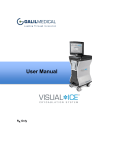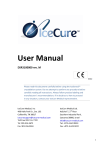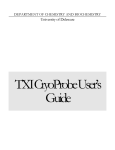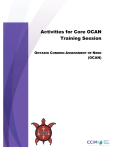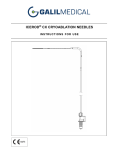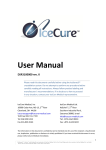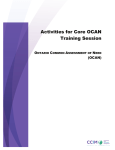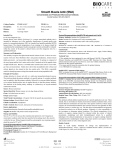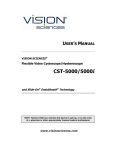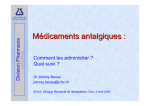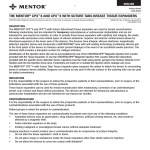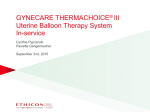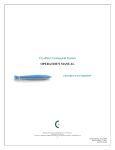Download RESOURCE GUIDE
Transcript
RESOURCE GUIDE PATIENT BENEFITS – Non-surgical – – Less anxiety – – Half-hour procedure – – Office co-pay versus Hospital deductible – – Quick recovery – – Appropriately reimbursed – – Eliminate travel time to OR – – Less costly than hospital OR surgery – – No change in malpractice coverage – – Control schedule – – Utilize current staff – PHYSICIAN BENEFITS HEALTH CARE SYSTEM Safe & effective Easy to learn Minimal discomfort for your patients Appropriately reimbursed ~2~ In April 2001 Her Option® was approved by the FDA as a cryoablative device intended to ablate the endometrial lining of the uterus in pre-menopausal women. It has been used in over 25,000 procedures in the United States and since its initial introduction Her Option has become the only FDA approved in-office ablation therapy for the treatment of menorrhagia. Using Her Option within your office is a sound business decision that benefits your patients and practice. For patients, Her Option is a safe and effective method of ablation. Her Option’s unique cryoablation technology provides a natural analgesic response which results in minimal discomfort for patients, with no IV sedation required. Your practice benefits with a procedure that is easy to perform and uses ultrasound guidance for real-time visualization and peace of mind. Finally, Her Option has a higher reimbursement than traditional office procedures and requires a modest capital equipment expense. This Her Option Resource Guide was developed to provide you with office tools to help you get started. It includes a step-bystep outline of the procedure, lists of procedure supplies, suggested medications, and templates to use for your patients and for your medical records. We look forward to working with you as you incorporate Her Option into your practice and experience the benefits of Her Option first hand. ~3~ TA BLE OF CONT E NTS S E C T I O N I : P R E PA R AT I O N F O R T R E AT M E N T Patient Selection & Contraindications Preparation of Patient & Pre-procedure Instructions for the Patient Procedure Supply List Typical Medications Used Recommendations for Office-Based Treatments Keys to Success for In-Office Comfort 5 6 7 8 9 10 S E C T I O N I I : P RO C E D U R E I N S T RU C T I O N S Pre-Procedure Options Procedure Steps - Position Patient - Local Anesthesia - Prepare Cryoprobe - Ultrasound - Beginning Freeze Cycle - 2nd Freeze Cycle - Post-Procedure Instructions - Post-Procedure Expectations 11 11 11 11 12 12 13 14 15 15 S E C T I O N I I I : P R AC T I C E F O R M S / T E M P L AT E S In-Office Patient Questionnaire* Her Option Check List* Informed Consent Form* Pre-Procedural Instructions to Patient* Sample Procedure Note/ Data Collection Templates* Post-Procedural Instructions to Patient* 16 17 18 19 20 24 S E C T I O N I V: R E I M B U R S E M E N T Her Option Reimbursement Services S E C T I O N V: S U P P O RT M AT E R I A L AMS Support Materials Order Form Coversheet* S E C T I O N V I : S U M M A RY O F WA R N I N G S , P R E C AU T I O N S & CO N T R A I N D I C AT I O N S * Digital copies supplied on CD 25 26 27 28 H ER OP TI ON ® PAT IE NT SE LE CT ION OFFI CE CRYOABL AT ION T HE R AP Y PAT I E N T S E L E C T I O N Endometrial ablation is appropriate for patients with abnormal uterine bleeding due to benign disease in whom neither future fertility nor a hysterectomy is desired. Key patient selection criteria include: • Completion of childbearing • Normal pap smear and endometrial biopsy • Absence of uterine abnormalities which distort the uterine cavity to the extent of preventing adequate treatment See Her Option® User’s Manual 030-02096-001 product labeling for more detailed information. CO N T R A I N D I C AT I O N S The device is contraindicated for use in: • Patients who are pregnant or wish to become pregnant in the future • Patients with a known or suspected endometrial carcinoma or premalignant change of the endometrium • Patients with an active genital or urinary tract infection at the time of the procedure • Patients with an active pelvic inflammatory disease • Patients with an IUD currently in place • Patients with an anatomic or pathologic condition in which weakness of the myometrium could exist, such as history of previous classical cesarean sections or transmural myomectomy Patients should also have blood tests to understand presence of bleeding disorders or thyroid disease. Once the preoperative evaluation has been completed and the patient has failed conservative therapy, i.e., D&Cs, hormones, etc., she is a candidate for ablation. ~5~ PRE-TREAT M E NT CHE CKLIST P R E PA R AT I O N O F PAT I E N T A urine pregnancy test should be performed within 3-4 weeks prior to treatment. Consent for treatment should be signed at this time rather than on the day of treatment, as the patient consent could be construed to have been signed while under the influence of preoperative medications. If a sedative is used, patients should arrange for transportation to and from the treatment facility. Pre-Treatment A thinned uterine lining is recommended prior to treatment. The following options may be used: • Natural option – Timed to the early proliferative phase, right after period ends • Medical options – Provera or other progestins – Lupron (3 to 4 weeks) – Birth control pills P R E - P RO C E D U R E I N S T RU C T I O N S F O R T H E PAT I E N T Patients should be provided with a pre-procedure instruction sheet. A sheet such as the sample included on page 18 will help prepare the patient and help ensure that the day of the procedure goes smoothly. The sheet should be customized to include specific patient recommendation, and physician office contact information. Common office pre-procedure patient instructions: • On the day of treatment the patient may have a light meal 30-45 minutes prior to treatment • Have the patient arrive at your office approximately one hour prior to the procedure time • The patient should have a comfortably full bladder prior to treatment ~6~ HER OPTI ON ® P ROCE DU R E SU P P LY LIST • Regular or large speculum (preferably open-sided) • Tenaculum • One 10cc Luer lock syringe for the paracervical block (optional) • 50cc sterile saline, room temperature (optional) • Ultrasound machine with abdominal transducer • Ultrasound gel • Topical cervical anesthetic, e.g., Hurricaine® (optional) • 4x4 sterile gauze and long Q-tip • 30cc 0.25% bupivacaine (optional) • Uterine sound • Uterine dilators up to 6mm • Alcohol wipes • For paracervical block: Reusable needle extender and a disposable 22-gauge standard needle or one extended dental needle (optional) • Betadine or other topical antiseptic for vaginal prep • Gloves, etc. ~7~ HER OP TI ON ® T YPICAL M E DICAT IONS U SE D TYPE OF DRUG DRUG NAME (GENERIC) USUAL DOSE & TIMING Local Anesthetic Lidocaine® (Xylocaine) 15-20 cc of .5 – 1% solution in PC Block Short acting Local Anesthetic Marcaine® (Bupivacaine) 10-20 cc of .25% solution in PC Block Longer acting for women who can’t take anti-inflammatory Analgesic/NSAID Ibuprofen PO: 600-800mg 1 hour prior to procedure and up to 1 day post procedure Analgesic/NSAID Aleve® (naproxen) PO: 800mg 1 hour prior to procedure and up to 1 day post procedure Analgesic/NSAID Toradol® (ketorolac) PO: 20mg 1 hour prior to procedure IM: 30-60mg Analgesic/Narcotic Vicodin® (500mg acetaminophen w/ 5mg hydrocodone) PO: 1 – 2 tablets 1 hour prior to procedure and up to 1 day post procedure Analgesic/Narcotic Vicoprofen® PO: 1 tablet 1 hour prior to procedure and up to 1 day post procedure Anxiolytic/Amnestic Valium® (diazepam) PO: 5-10mg 1 hour prior to procedure Anxiolytic/Amnestic Ativan® (lorazepam) PO: 1-2mg 1 hour prior to procedure Sublingually 10 min before procedures List includes possible medications that can be used prior to or post procedure for pain management. ~8~ HER OP TI ON ® R E COM M E NDAT IONS F OR OFFICE-B ASE D T R E AT M E NTS As is the case with office based procedures such as endometrial biopsy, loop electrosurgical excision procedure [LEEP], hysteroscopy and endometrial ablation, physicians that perform Her Option Office Cryoablation Therapy should follow these general recommendations: • Vasovagal effects can occur with any manipulation of the cervix. Office personnel should be trained in airway management, with advanced cardiac life support. • Prepare an emergency kit with appropriate pharmacological agents to assist in managing emergency situations; be prepared to check blood pressure and provide hemostasis for cervical lacerations. • Know your local anesthetic’s maximum dose. To avoid the risk of overdose draw out the maximum dosage. Overdose symptoms include: dizziness, lightheadedness, tinnitus, depression, and systole. In case of severe reaction be prepared to administer appropriate pharmacological agents. ~9~ HER OPTI ON ® KEYS TO SU CCE SS FOR IN - OF F ICE COM F ORT Patients are more comfortable if the clinician explains what will happen during and after the procedure. Knowing what to expect can alleviate much of the anxiety patients feel throughout the treatment and recovery periods. Here are additional recommendations for providing in-office comfort: • Provide a procedure room that is quiet, relaxing, and comfortable • Provide a blanket and pillows to make the patient more comfortable • Turn down the lights • Provide soft music in the room or on head phones to calm her nerves • Encourage the patient to eat a light meal before the procedure so she is not hungry • Encourage the patient not to void prior to the procedure so that her bladder is naturally full and a Foley is not required Encourage staff to be: ✓ Calm, friendly, empathetic, gentle and unhurried ✓ Attentive to the patient, listen to her and make her needs their first priority ✓ Respectful of the patient’s privacy and confidentiality ~ 10 ~ HER OP TI ON ® P ROCE DU R AL INST RU CT IONS The following instructions are designed to provide you a step-by-step overview of the Her Option procedure. For the comprehensive instructions for use, please see the owners manual. I . P R E P RO C E D U R E O P T I O N S • Valium or Ativan, one-hour before • Toradol (or other NSAIDs may be used) I I . P RO C E D U R E S T E P S Position Patient: – Position the patient on the exam table and place in stirrups or footrests – Reconfirm uterine position by pelvic exam – An abdominal ultrasound is performed to note bladder fullness and visibility of the uterus If necessary, add fluid to the bladder to permit proper uterine visualization – Gently prep the perineum and if possible the vagina – Place sterile vaginal lubricant onto the tips of a large open-sided speculum and place into the vagina – Open the speculum fully and secure in place Local Anesthesia (May not be required with a parous cervix) – Apply a topical anesthetic: either 10-20cc of lidocaine; or a topical spray such as Cetacaine® may be applied to the cervix and cervical canal – Insert a single tooth tenaculum to the anterior cervical lip – Apply gentle traction to the cervix and displace to one side of the vagina to facilitate the paracervical injection to the 1st side – Paracervical Block: Use up to 10 cc of 1/4% bupivacaine on each side at the 4 and 8 o’clock positions. See Table I for additional information regarding PC Block and toxicity levels – Allow 5 minutes for the analgesia to take effect – if required, dilate the cervix to 6mm TA B L E 1 : G E N E R A L I Z E D M E T H O D O F P E R F O R M I N G A P C B LO C K . D O S AG E D E L I V E R E D W I T H A N I N J E C T I O N VO LU M E O F 2 0 - 3 0 C C . Injection volume (cc) Dose Delivered (mgm) 1/4% bupivacaine 20 50 1/4% bupivacaine 30 75 1/2% bupivacaine 20 100 1/2% bupivacaine 30 150 Toxicity level (mass dependent) 175 ~ 11 ~ HE R OP TI ON ® P ROCE D UR AL INST RU CT IONS CONTINUED Prepare Cryoprobe – Depress the power On/Off button on the front of the console (power-up will take approximately 3 minutes) – LCD display will show the “Her Option®” logo and two choices, select start to begin the procedure – The display panel directs the user to “Please Attach New Disposable”. At this time remove the disposable cryoprobe from the tray – Connect the cryoprobe sheath over the cryoprobe and lock it into place – Pull the sterile plastic sheath over the handle and black flex line – Initiate PreCool when prompted by the console LCD panel Caution: It is very important that the PreCool cycle be conducted using the disposable cryoprobe that will be used for the treatment. Test cryoprobes should NOT be used for PreCool cycle. Ultrasound – Grasp the tenaculum and apply gentle traction to straighten out the uterus – Carefully insert the cryoprobe slowly into the uterus and observe its path on the ultrasound – Advancing the cryoprobe, gently touch the right cornual area of the uterine cavity and confirm sonographically that the probe is inside the uterine cavity in a longitudinal view – You can confirm the probe is on the right sonographically in the transverse view ~ 12 ~ HE R O PTI ON ® PROCE DU R AL INST RU CT IONS CONTINUED – Apply gentle traction to the tenaculum and hold the probe with the tip in the right cornual area – Inject approximately 5 cc of sterile saline through the bottom injection port, if desired, to improve ultrasound visualization Beginning Freeze Cycle – Depress the negative [-] (freeze button) on the disposable cryoprobe to start the freeze cycle A green light will appear on the cryoprobe indicating that freezing is occurring – Maintain the cryoprobe and tenaculum pressure until the cryoprobe tip temperature reaches minus 60 degrees centigrade – Relax tension on the cryoprobe and tenaculum and observe the gradual expansion of the cryozone on the ultrasound using both longitudinal and transverse views. The very dark or black area corresponds to the formation of the ice along and extending out from the cryoprobe cryozone formation - Ultrasound view – Continue the first treatment session for 4 minutes or until the cryozone gets within 5 mm of the serosa of the uterus – Depress the positive [+] (heat button) on the disposable cryoprobe – The amber illumination on the keypad. The LCD display on the console will read, “Wait to Move Probe”. This message will disappear when the cryoprobe tip temperature reaches positive 20ºC ~ 13 ~ HE R O PTI ON ® PROCE D U R AL INST RU CT IONS CONTINUED – Once the “Wait to move probe” message disappears, gently rotate the cryoprobe back and forth and slowly withdraw the cryoprobe from the first cryozone – It is not necessary to remove the cryoprobe from the uterus, but it must be withdrawn out to or near the internal cervical os – Reposition the cryoprobe handle to the opposite side of the uterus – Apply gentle traction on the tenaculum and gently slide the cryoprobe along side of the cryozone into the untreated cornu – If resistance is encountered due to the previous cryozone, hold the cryoprobe in position and allow the heated tip to melt through the frozen section into the untreated side Injection of warm saline will facilitate the passage of the cryoprobe 2nd Freeze Cycle – – – – Reconfirm by ultrasound that the cryoprobe is near the fundus and into the untreated cornu Depress the minus [-] button to start the second freeze cycle Once the cryoprobe tip reaches minus 60ºC tension may be relaxed Observe the developing cryozone as previously outlined in both longitudinal and transverse view. Observation of the cryozone growth is best viewed through transverse view – Continue freezing for 6 minutes or until the advancing edge of the cryozone gets within 5 mm of the serosa – The second cryozone should completely merge with the first cryozone CryoZones merging after 2nd freeze – Depress the plus (+) (heat button) to begin the heat cycle – At 20ºC, begin rotating the cryoprobe and remove it from the uterus – Remove the tenaculum from the cervix. Achieve hemostasis of the tenaculum sites if necessary – Remove the speculum – The Heat Cycle ends when the display panel reads “Standby”. Press Exit and select Yes to ~ 14 ~ HE R OPTI ON ® P ROCED U R AL INST RU CT IONS CONTINUED “End Procedure” Post-Procedure Instructions – – – – Have the patient position herself so that she is fully supported on the exam table Have the assistant place a sanitary pad Allow the patient to rest comfortably for 15 minutes Many physicians send the patient home with an NSAID or Percocet® for cramping and schedule an office follow-up – Patients should be advised that they may conduct normal activities, but no strenuous exercise, sexual activity, douches or tampons until after the 2 week office visit Post-Procedure Expectations – – – – Cramping post-operative Up to 4 weeks of watery discharge (usually less) Reduction or elimination of menstrual bleeding within first 3 months following procedure “True” indication of results at 6 months ~ 15 ~ 1 IN 4 WOMEN SUF F E R F ROM HE AV Y BLE E DING A RE YO U ONE OF T HE M ? ■ If you answer yes to any one of the following questions, you may be suffering from heavy bleeding. • Does your period last longer than seven days? ____Yes ____No • Do you use more than 3 pads or tampons per day? ____Yes ____No • Do you feel the need to double up on feminine protection? ____Yes ____No • Do you become fatigued due to your heavy bleeding? ____Yes ____No • Does your heavy bleeding affect your social, athletic or sexual activities? ____Yes ____No • Do you miss work because of your periods? ____Yes ____No • Do you pass clots during your periods? ____Yes ____No • Do you avoid leaving your home for fear of accidents? ____Yes ____No • Do you avoid wearing light colors during your period? ____Yes ____No • Has medication (birth control pills) failed to help your heavy bleeding? ____Yes ____No ■ Are you interested in learning more about a one time treatment for heavy bleeding that is safe, non-surgical and may be provided in the comfort of your ____Yes ____No physician’s office? ■ After you have completed this patient questionnaire, please present this to your physician and ask him/ her to discuss your heavy bleeding options, including whether the Her Option® Office Cryoablation Therapy is right for you. ~ 16 ~ – SAMPLE – HER OPT ION ® CHE CK LIST Patient Name: DOB: When scheduling Her Option, initial next to each item below when they have been completed. If results of tests are not clear, review them with the scheduling physician. Check with the physician regarding what scripts she/he wants the patient to have. Remember to check the patient’s allergies. Consents must be signed before the patient takes any medications the day of the procedure. Endometrial Biopsy: normal / abnormal Ultrasound: Sonohysterogram or Hysterscope: intrauterine cavity normal / abnormal Contraception: OCP, tubal ligation, partner vasectomy, other Consents signed: Procedure date scheduled: Instructions pre and post given to patient: Pre-authorization sent: Pharmacy number: Scripts: Allergies: Toradol 60mg IM vial, disp: one Valium 5mg / 10mg disp: one sig: one po one hour before procedure Vicoden ES disp: 10 sig: one po q 4-6 hours prn pain Darvocet N100 disp: 10 sig: one po q 4-6 hours prn pain Vibramycin 100mg tabs disp: 14 sig: one po bid Pre-authorization received: Patient notified of copay: ~ 17 ~ – SAMPLE – H ER OP TI ON ® INF OR M E D CONSE NT I, ________________________________________, hereby authorized the physicians of _________________________________________ to perform cryoablation of my uterus. This procedure has been clearly explained to me. The alternatives to this procedure have been discussed. The physician has answered my questions to my satisfaction. I understand that the purpose of cryoablation is to cause the sloughing off of the endometrium (the lining of the uterus). I understand that I may feel discomfort and/or cramping during the procedure. I understand that certain complications can sometimes result from cryoablation. These complications include, but are not limited to, bleeding, uterine scarring, uterine perforation with injury to inter-abdominal contents, and infection of the uterus or other pelvic organs. Some complications may result in a need for a hysterectomy. The medical literature has indicated that the general success rate for this procedure in treating abnormal vaginal bleeding is approximately 90 percent. Twenty to thirty percent (20-30%) of the patients will experience total resolution of their periods. Cryoablation may not decrease menstrual cramps or pain. Cryoablation is not a form of birth control. Pregnancy is still a possibility after cryoablation. Effective birth control continues to be important after this procedure. Should pregnancy occur, there is a higher than normal chance of ectopic (tubular) pregnancy, miscarriage, premature delivery or birth defects that can be dangerous for both mother and fetus. Following the procedure, I have been informed that I can expect as a normal result of the procedure a heavy watery discharge for up to 1-3 weeks. I understand that intercourse should be avoided until the discharge stops. I understand that my first menstrual cycle after this procedure may be heavier than normal with passage of tissue. I have read the above and I fully understand the nature, purpose, risk and alternatives to this procedure and I am willing to undergo the procedure. _______________________________________ WITNESS _______________________________________ PATIENT ______________________ DATE ~ 18 ~ – SAMPLE – HE R OP TI ON ® OFFICE CRYOABL AT ION T HE R AP Y P RE P ROCED U R AL INST RU CT IONS You may have a light meal prior to coming to the office if desired. You will need to have fluid in your bladder for the procedure so be sure to drink (2) 8 oz glasses of water before you arrive at the office. You can plan on your appointment taking about 1 hour. The actual procedure lasts for 1/2 hour but you will need to remain in the office for a short period after the procedure. You may feel drowsy from the medication administered prior to and during the procedure. You should arrange for transportation to and from the procedure. The following medications have been prescribed to you. Please follow the doctor’s instructions in taking these medications: ________________________________________________________________________ ________________________________________________________________________ ________________________________________________________________________ Your procedure is scheduled for: Date: ___________________ Time: ___________________ If you have any questions prior to your procedure please call our office. OFFICE PHONE NUMBER:_______________________________ ~ 19 ~ – SAMPLE – H ER OP TI ON ® P ROCE DU R AL NOT E A sample procedure note is included below for your information. A procedural note should be customized for each patient and included in the patient file. The collection of patient data can be useful in identifying trends and outcomes across a combined patient population. A data collection form is included on the following page. Sample Cryoablation Procedure Note PAT I E N T: ___________________ D AT E : ______________________ D R . _________________________ D I AG N O S I S : Excessive Uterine Bleeding / Menorrhagia T R E AT M E N T: Endometrial cryoablation with intraoperative ultrasonic guidance A N E S T H E S I A : Paracervical Block Placement with 0.25% Marcaine and 1% Lidocaine P RO C E D U R E : The patient was brought into the treatment room with a consent form on the chart knowing all the risks benefits of the procedure. Preoperative valium 10 mg and motrin 800 mg was given one hour prior to the treatment. The patient was placed in the dorsal lithotomy position and a speculum was inserted. At that point the paracervical block was administered with marcaine and lidocaine 20 cc in total. A single tooth tenaculum was placed on the cervix on the anterior lip in a transverse fashion. Cervical dilation was accomplished in standard fashion. Cryoprobe was inserted to the fundus of the uterus after uterine sound determined the size of the cavity. Cryoablation technology was used and the freeze button depressed. Ultrasound was used to monitor the growth of the cryozone. Heat button was depressed after 4 minutes and the cryoprobe was repositioned to the the contralateral cornua and freeze button depressed. Cryozone was again monitored with ultrasonic guidance. Heat button depressed after 6 minutes and cryoprobe removed. Pt was comfortable throughout the procedure. Speculum removed and pt was given bextra 10mg for 12 days. A followup visit was arranged 2 weeks post operative. E L E C T RO N I C S I G N AT U R E ~ 20 ~ – SAMPLE – H ER OP TI ON ® P ROCE DU R AL NOT E 2 PATIENT: _________________________ DOB: _______________________ DATE OF PROCEDURE: ___________ CONSENTS SIGNED: ___________________ D I AG N O S I S : _________________________ V I TA L S : T I M E _______________ B P _____________ M E D I C AT I O N S : _____________ LOT # _____________ T I M E _____________ E X P _____________ P _____________ P RO C E D U R E : The patient was placed in the dorsal lithotomy position and a speculum was inserted. The cervix and vagina were cleaned with Betadine. A single tooth tenaculum was placed on the anterior lip of the cervix. Under ultrasound guidance, the Her Option probe was introduced into the uterine cavity and the procedure was performed. The following order, locations, and freeze times were used. LOCATION OF FREEZE 1._______________________ 2._______________________ 3._______________________ 4._______________________ LENGTH _____ _____ _____ _____ minutes minutes minutes minutes Upon completion of the procedure, the instruments were removed and the patient was assisted to another exam room where she was observed. Vitals: Time _________ BP _________ P _________ The patient tolerated the procedure well and was released in stable condition with her driver along with a copy of the post procedure instructions which were reviewed with her. She is to return to the office in _______ months with a menstrual diary. PH Y S I C I A N : __________________________________________________ ~ 21 ~ – SAMPLE – HE R OP TI ON OFF ICE CRYOABL AT ION T HE R AP Y D ATA COLLE CT ION ® Physician’s Name: _________________________________ Data of Cryoablation treatment:___________ P R I O R TO C RYOA B L AT I O N • Symptoms of Menorrhagia: ❑ Moderate ❑ Severe • Uterine sound measurement: ____________cm • Pre-treatment evaluation: ❑ Ultrasound ❑ Hysteroscopy ❑ Hystosonography • Uterine Dimensions: Width (cornua to cornua) ___________ Length (serosa to internal os) ____________ • Endometrial stripe dimensions: Width __________________________ Length _____________________________ • Are myomas present? ❑ Yes ❑ No If Yes list Location Number Size 1. ____________________ ____________________ ____________________ 2. ____________________ ____________________ ____________________ 3. ____________________ ____________________ ____________________ 4. ____________________ ____________________ ____________________ Are polyps present? Septate Uterus? Other (specify) ❑ Yes ❑ Yes ❑ No ❑ No Pre-treatment: ❑ GnRH Name __________________________________ When given: __________________ Dosage __________________ ❑ D&C ❑ None CONTINUED ON NEXT PAGE ~ 22 ~ – SAMPLE – HE R OP TI ON OFFICE CRYOABL AT ION T HE R AP Y D ATA COLLE CT ION CONTINUED ® During Cryoablation: • Uterine sound measurement: ____________cm • Patient’s Menstrual Stage: ❑ Menstrual ❑ Proliferative ❑ Secretory ❑ Premenstrual • Freeze Pattern and Duration: Location of Freeze: ____________________ ____________________ ____________________ ____________________ Length of Freeze: ____________________ ____________________ ____________________ ____________________ PAT I E N T F O L LOW- U P • Data of hysteroscopy: ______________ • Symptoms of Menorrhagia: ❑ Moderate ❑ Severe ❑ NIL ❑ None • Patient’s Menstrual Stage: (Note: For best evaluation results hysteroscopy must be completed during early Proliferative Phase) ❑ Menstrual ❑ Proliferative ❑ Secretory ❑ Premenstrual • Hysteroscopy Findings: Are myomas present If Yes list Location ❑ Yes ❑ No Number Size 1. ____________________ ____________________ ____________________ 2. ____________________ ____________________ ____________________ 3. ____________________ ____________________ ____________________ Are polyps present ❑ Yes ❑ No Presence of Endometrium ❑ Yes ❑ No If Yes, specify Location(s) ________________________________________________ Other (specify) ________________________________________________________ • Hysteroscopic Images attached ❑ Yes ❑ No • Type of treatment to follow: Repeat Ablation ❑ Yes ❑ No If Yes specify ablation method _________________ Hysterectomy ❑ Yes ❑ No Medication ❑ Yes ❑ No Specify _______________________________________ None ❑ ~ 23 ~ – SAMPLE – HE R OP TI ON ® OFFICE CRYOABL AT ION T HE R AP Y PO S T PROCED URA L I NST RU CT IONS F OR T HE PAT I EN T You may experience mild to moderate cramping (like menstrual cramping) and pinkish watery discharge. This may last approximately 2 to 3 weeks. Use pads, not tampons during this time. No sexual activity for 2 weeks post procedure. Follow up medications and directions for taking the medications are: ________________________________________________________________________ ________________________________________________________________________ ________________________________________________________________________ C A L L O U R O F F I C E I F YO U D EV E LO P A N Y O F T H E F O L LOW I N G : • • • • • Fever of 100.4 or greater Worsening pelvic pain Nausea Vomiting Greenish vaginal discharge with odor OFFICE PHONE NUMBER:_______________________________ Your post procedure follow up visit is scheduled for: Date: ___________________ Time:___________________ ~ 24 ~ HER OPTI ON ® RE IM BU R SE M E NT SE RV ICE S AMS Health Care Affairs (HCA) team offers reimbursement services for Her Option®. Our reimbursement team will confirm benefits and fee schedules for each insurance provider. The HCA team can provide you with confirmation of: • Effective date of coverage • Patient plan specific benefits • Any deductibles or co-pays • Patient co-insurance percentages • Instructions on any additional request by the health plan To take advantage of the services provided by the AMS Health Care Affairs team, call (866) FORCRYO/(866) 367-2796. ***Please note that the benefits quoted are NOT a guarantee of payment and are subject to medical necessity. AMS uses reasonable efforts to obtain eligibility and benefit information from the insurance company and all information contained herein represents what has been relayed to AMS from the insurer’s representative. AMS is not responsible for inaccurate information quoted by the insurance company representative. ~ 25 ~ H ER OP TI ON ® SU P P ORT M AT E R IALS We want to help make your office ablation practice a success. To find out what practice marketing resources are available please contact your Her Option representative. To order support material contact Customer Service: 1-800-328-3881 Literature Hotline: x7614 or Fax request by filling in quantities and using the cover sheet on the following page. ~ 26 ~ A M S S U P P O RT M AT E R I A L S O R D E R F O R M COV E R S H E E T TO : Customer Service Fax: 1-800-366-9035 Literature Hotline: x7614 F ROM : D ATE : S HIP TO : ( INCLUDING # PAGES COVER ): ~ 27 ~ SUMMA RY OF WA RNING S, P R E CAU T IONS AND C ONTRA I ND I CATIONS F OR T HE HE R OP T ION ® CRYOA BL AT ION T HE R AP Y SYST E M The Her Option® Cryoablation Therapy System is a closed-cycle cryosurgical device intended to ablate the endometrial lining of the uterus in pre-menopausal women with menorrhagia or excessive bleeding due to benign causes for whom childbearing is complete. • The device is contraindicated for patients who are pregnant or who desire to become pregnant in the future, patients with a known or suspected endometrial carcinoma or premalignant change of the endometrium or have an active genital or urinary tract infection. • The device is contraindicated for patients with active pelvic inflammatory disease (PID), an intrauterine device (IUD) currently in place and patients with any anatomic or pathologic condition in which weakness of the myometrium could exist. • Endometrial ablation does not eliminate the potential for endometrial hyperplasia, or adenocarcinoma of the endometrium and may mask the condition. • Patients who undergo endometrial ablation procedures who have previously undergone tubal ligation are at increased risk of developing post ablation tubal sterilization syndrome. • There is the potential for thermal injury to adjacent organs if the cryozone extends beyond the serosal surface of the uterus. • As is the case with any office based procedure, physicians should be prepared for an emergency. General recommendations for such emergencies include having an emergency kit on hand with appropriate pharmacological agents. Office staff should be trained in airway management and advanced cardiac life support. For a complete list of indications, contraindications, warnings and precautions, refer to the Instructions for Use for the HerOption Cryoablation Therapy System. ~ 28 ~

































